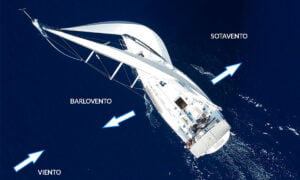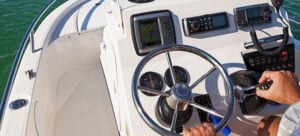The navigation area is a fundamental concept in nautical, which we must be clear about both when decide on a title or another as before choose the most appropriate boat for our needs. Do you know what the navigation zone is and how it affects you? Keep on reading to know everything.
If you are interested in the navigation areas, in this article we will talk about the navigation with the PER outside Spain
What does the concept navigation zone mean?
We can define the navigation area as the portion of water located at a certain distance from the coast and delimited by that same distance in which a boat can navigate, depending on its characteristics and the safety equipment it has, depending on the provisions of Royal Decree 1185/2006, of October 16. This standard defines 7 maritime zones:
- Zone 1: navigation unlimited.
- Zone 2: up to 60 miles of the coast.
- Zone 3: up to 25 miles of the coast.
- Zone 4: up to 12 miles of the coast.
- Zone 5: up to 5 miles from an accessible beach or sheltered area.
- Zone 6: same as 5, but at a maximum distance of 2 miles.
- Zone 7: limited to protected coastal waters, ports, bays and any other protected waters.
Mandatory material depending on the area
As we have already explained, when allowing a boat to navigate through one area or another, one of the issues that is taken into account is the safety equipment which the ship has. Next, we will see what material is necessary to carry depending on the navigation area to be navigated:
- Zone 7: life jackets for the 100% of the people on board, manual pressure fog horn, national flag, signal mirror and signal code, as long as it has radio communications equipment, in addition to other weapons and extinguishing materials.
- Zone 6: All of the above, plus 3 hand-held flares with red light.
- Zone 5: in addition to the above, a type No. 4 first aid kit.
- Zone 4: everything required in previous areas and, in addition, 1 lifebuoy with light and buoy, 6 rockets with red light and parachutes, 6 hand-held flares with red light, 1 floating orange smoke signal and 1 fire bucket with boat of at least 7 liters, as well as charts and nautical books and a signal mirror, among other devices.
- Zone 3: In addition to what has already been stated, the material must include life rafts for the people on board and a rescue raft-type first aid kit.
- Zone 2: to navigate in zone 2 it will be necessary to carry 2 floating orange smoke signals instead of one and 2 fire buckets with tails, 3 if the boat is longer than 20 meters.
- Zone 1: in terms of safety material, it is mandatory to have everything necessary for zone 2, expanding the equipment in the nautical, various weapons, fire extinguishing and radio communications sections.
Are you interested in: What is the nautical Titulín and what boats can I govern?

Design category, how does it relate to the area?
The design category marks the characteristics that the boat must have to sail, as well as in which area it is allowed to do so, under the indications of Directive 2013/53/EU, which establishes aspects such as the structure of the boat and What conditions you will have to face depending on the distance from the coast and the type of waters in which it sails: the greater the distance, the ship must be able to cope with more unfavorable conditions and for a longer time.
According to the regulations, there are 4 different design categories:
- Category A – Ocean navigation. The boat must be able to withstand winds of more than 40 knots on a sustained basis, as well as waves of more than 4 meters.
- Category B - High seas. It can withstand winds of up to 40 knots and waves of up to 4 meters.
- Category C – Coastal waters. Winds of up to 25 knots and waves of up to 2 meters.
- Category D – Inland waters and protected waters. The boat is only required to withstand up to 15 knots of wind and waves of up to 30 centimeters.

How do navigation zones and design categories correspond?
Each of the design categories allows users ships of said category navigate in one or more navigation areas, in relation, precisely, to the type of inclemency they can withstand.
| Design Category | Denomination | Maximum distance |
| TO | Oceanic | Unlimited |
| b | High seas | 60 miles |
| c | Coastal waters | 12 miles |
| d | Protected waters | Inland waters |
Can the design category of a boat be changed?
As we have explained, the category of the vessel is given by the its resistance to possible adverse circumstances that may have to be faced during navigation based on certain naval engineering tests to which the ship is subjected. With them the category is determined, but also the navigation area and the power of the ship.
On certain occasions it is possible to change the navigation category to a higher one, for example if the power is going to be increased or if the boat is going to be used for some use that requires it. For this, a authorized company and a naval engineer They must prove that the vessel meets the necessary conditions and present the project to the Maritime Captaincy corresponding, where the Chief of Maritime Inspection will grant, or not, the change.
And the navigation area?
In this case, we have to look at the ship construction date:
- On boats prior to 1998 it is possible to change the zone of navigation, since they do not have CE marking, which leaves it to the discretion of the maritime captains to establish the permitted areas for each vessel.
- On boats After 1997 the zone cannot be changed: They have CE marking and the navigation area is delimited by the design category of the boat and cannot be increased.
Correspondence between navigation areas and nautical titles
But not only the boat delimits the permitted navigation areas: you can go more or less into the sea depending on the nautical title that you have. Below you can consult the correspondences:
- yacht captain: any navigation area.
- yacht pattern: enabled to navigate zones 2, 3, 4, 5, 6 and 7.
- Recreational Boat Skipper (PER)- You can navigate through zones 4, 5, 6 and 7.
- Basic Navigation Pattern (PNB): enabled in zones 5, 6 and 7.
- Navigation License: You can only steer vessels in zones 6 and 7.





